
Caenorhabditis elegans is a free-living transparent nematode about 1 mm in length that lives in temperate soil environments. It is the type species of its genus. The name is a blend of the Greek caeno- (recent), rhabditis (rod-like) and Latin elegans (elegant). In 1900, Maupas initially named it Rhabditides elegans. Osche placed it in the subgenus Caenorhabditis in 1952, and in 1955, Dougherty raised Caenorhabditis to the status of genus.
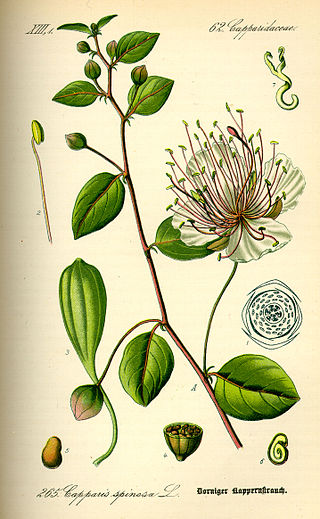
Capparis spinosa, the caper bush, also called Flinders rose, is a perennial plant that bears rounded, fleshy leaves and large white to pinkish-white flowers.

The Capparaceae, commonly known as the caper family, are a family of plants in the order Brassicales. As currently circumscribed, the family contains 15 genera and about 430 species. The largest genera are Capparis, Morisonia, Maerua, Boscia, and Cadaba.

Kaeng Krachan National Park is the largest national park of Thailand. It is on the border with Burma, contiguous with the Tanintharyi Nature Reserve. It is a popular park owing to its proximity to the tourist town of Hua Hin. It was named a UNESCO World Heritage Site on 26 July 2021, despite concerns from the OHCHR around the human rights violations of the indigenous people that live in the park.

Capparis is a genus of flowering plants in the family Capparaceae. It includes 142 species of shrubs or lianas which are collectively known as caper shrubs or caperbushes. Capparis species occur over a wide range of habitat in the subtropical and tropical regions of Africa, Eurasia, Australasia, and the Pacific.
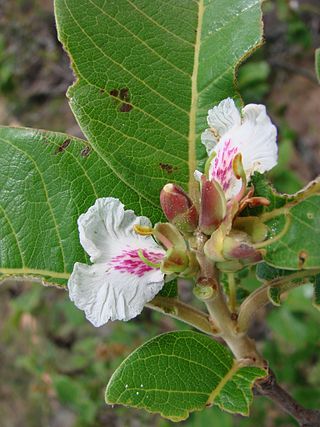
Qualea is a flowering plant genus in the family Vochysiaceae. These plants occur in the Neotropics and their wood makes good timber and firewood and is used in construction. Some species of Qualea have medicinal properties.
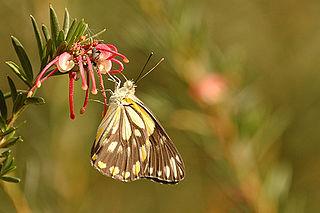
Belenois java, the caper white or common white, is a small butterfly of the family Pieridae found in Australia, Indonesia, and Melanesia. It is highly migratory and is often confused with the cabbage white.
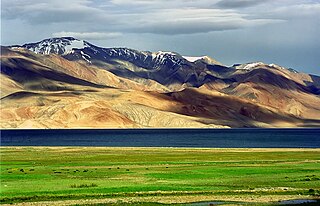
The Karakoram-West Tibetan Plateau alpine steppe is a montane grasslands and shrublands ecoregion found in parts of Pakistan, China, Afghanistan, and India.

Capparis tomentosa, the woolly caper bush or African caper, is a plant in the family Capparaceae and is native to Africa.
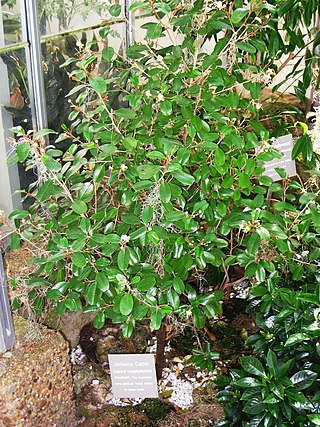
Capparis cynophallophora, commonly known as the Jamaican caper, is small tree in the caper family, Capparaceae, that is native to the Neotropical realm.
WormBase is an online biological database about the biology and genome of the nematode model organism Caenorhabditis elegans and contains information about other related nematodes. WormBase is used by the C. elegans research community both as an information resource and as a place to publish and distribute their results. The database is regularly updated with new versions being released every two months. WormBase is one of the organizations participating in the Generic Model Organism Database (GMOD) project.

Wasnal is a village in the Kallar Kahar Tehsil of Chakwal District, in Punjab, Pakistan. It is approximately 27 kilometers away from Kallar Kahar town leading toward Sargodha highway located 6 kilometers away from Munara bypass of main road. It is bordered by Jhamra to east, Nurpur Sethi to southeast, Munara to southwest and rest of border is surrounded by landscapes and beautiful green mountains.

Doliocarpus is a genus of flowering plants in the family Dilleniaceae, native to Central and South America.
Mammillaria elegans is a species of cacti in the tribe Cacteae. It is native to Mexico. Mammillaria elegans A.P. de Candolle 1828. is a 'nomen confusum' also applied to Mammillaria haageana subsp. elegans and refers both to Mammillaria geminispina with latex in the stem and to Mammillaria haageana, without latex in the stem Habit: Solitary, seldom branching cactus.
Fridericia elegans is a species of plants in the family Bignoniaceae. It is found in Brazil, where it is poisonous to livestock and has caused severe losses.

Capparis sepiaria, also commonly called hedge caper or wild caper bush, is a shrub that has a pantropical distribution, especially in dry deciduous forests, foothills and scrub jungles.
Capparis orientalis is a species of plants in the family Capparaceae.












